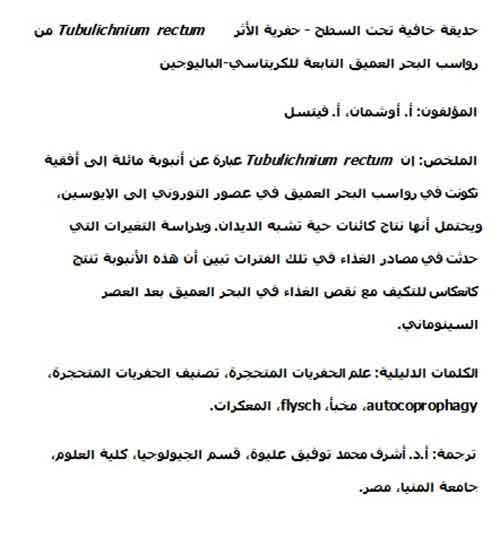Hidden subsurface garden on own faeces – the trace fossil Tubulichnium rectum (Fischer-Ooster, 1858) from the Cretaceous-Palaeogene deep-sea sediments
Plain Language Abstract
In the deep-sea, food for benthic organisms is mainly provided by organic matter produced in the photic zone that settles to the seafloor. Due to large water depth, the settling time of organic matter is long and hence, a high proportion of this material becomes oxidized. Thus, the deep-sea floor represents a food-limited habitat. Consequently, a specialized nutritional strategy is essential for long-term survival. To ingest organic-rich material that arrived after a bloom in surface water on the seafloor and to store it in anoxic sediment for later utilization is a successful strategy as described in this study.
Resumen en Español
Reserva oculta en el subsuelo con las propias heces ¬– la traza fósil Tubulichnium rectum (Fischer-Ooster, 1858) de los sedimentos marinos profundos del Cretácico-Paleógeno
Tubulichnium rectum (Fischer-Ooster, 1858) es un tubo, entre oblicuo y horizontal, no ramificado, con terminación cerrada, que tiene márgenes densamente alineados con pellets elipsoidales de naturaleza fangosa. Se presenta en sedimentos marinos profundos de arena fina a fango, siliciclásticos y margosos, principalmente de Turoniense al Eoceno. Probablemente fue producido por organismos semejantes a "gusanos", los cuales se alimentaban de sedimentos ricos en materia orgánica depositados de manera estacional o episódica en el fondo marino. Los pellets fecales se concentraban en las partes profundas de la traza dentro de la zona anóxica más allá de la profundidad a la que usualmente penetran otros excavadores. Durante períodos de escasez de alimento, los pellets se utilizaron como una fuente de nutrición suplementaria. Este comportamiento de acumulación y uso de unas reservas se interpreta como una adaptación a la creciente competencia por los alimentos en el mar profundo después del Cenomaniense.
Palabras clave: icnología; icnotaxonomía; autocoprofagia; cache; flysch; turbiditas
Traducción: Enrique Peñalver (Sociedad Española de Paleontología)
Résumé en Français
Tubulichnium rectum (Fischer-Ooster, 1858) est un tube non branché, oblique à horizontal en cul-de-sac. Il possède une périphérie alignée avec pellets boueux ellipsoidales. Cet ichnotaxon est repartie du Turonian jusq'à l'Eocène et se retrouve dans des sediments marins sableux, siliclastiques et marneux de grand profondeur. Il est produit par des organismes vermiculaires qui se nourrissait de sediment riche en matière organique déposé saisonièrement ou occasionellement sur le fond marin. Les pellets fécales étaient gardés dans le tube plus profond que les terriers' qui pénètre la couche anoxique du sédiment. Pendant des périodes de pénurie alimentaires les organismes utilisaient les pellets comme source de nourriture. Le comportment de construire des dépots alimentaires est interprété comme adapdation à une competition augmentée dans l'abyssale après le Cénomanien.
Translator: Christian Meyer
Deutsche Zusammenfassung
Versteckte unterirdische Gärten auf eigenen Kot-Ausscheidungen – das Spurenfossil Tubulichnium rectum (Fischer-Ooster, 1858) in kretazischen bis paläogenen Tiefsee-Sedimenten
Tubulichnium rectum (Fischer-Ooster, 1858) ist ein schräg bis horizontal im Sediment verlaufender, unverzweigter, blind endender Gang, an dessen Rand sich dicht gepackt elliposidförmige pelitische Kotpillen befinden. Diese Spur tritt in feinsandigen bis pelitischen siliziklastischen und mergeligen Tiefsee-Sedimenten auf, vor allem vom Turon bis zum Eozän. Dieses Spurenfossil wurde wohl von einem wurmförmigen Organismus erzeugt, der organisch-reiches Material aufnahm, das saisonal oder episodisch auf der Meeresbodenoberfläche abgelagert wurde. Es wurde in Form von Kotpillen im Gang in anoxischem Sediment in so grosser Tiefe ausgeschieden, dass es sich ausserhalb der Reichweite anderer Organismen befand. Während Zeiten geringer Nahrungsverfügbarkeit wurden die Kotpillen vermutlich als zusätzlich Nahrung genutzt. Dieses Verhalten, in einem Lager nahrhaftes Material zu speichern, wird als Anpassung der erzeugenden Organismen an ein Habitat gesehen, in dem seit dem Cenoman eine zunehmende Konkurrenz zwischen benthischen Organismen um Nahrung besteht.
Translator: Andreas Wetzel
Arabic

Translator: Ashraf M.T. Elewa

